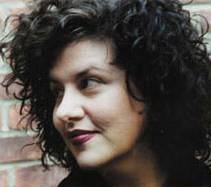From Roseto to the “Big Time”: An Interview with Adriana Trigiani
Every year in the town of Roseto, located in Pennsylvania’s slate belt, a new “Queen of the Big Time” is crowned during the town’s annual festival in honor of Our Lady of Mt. Carmel, held at the end of July. Roseto has about 1,650 residents; 42% of whom claim Italian ancestry. The Italians of Roseto are descendents of immigrants who arrived from Roseto Valfortore, in Puglia, Italy, where approximately 1,300 people live today. Each summer they all anxiously wait for the festival to see what lucky girl has won the coveted crown in the town's major social event of the year. This year, that lucky young lady was eighteen-year-old Mary Farino, seen at right. 
The “Big Time” Festival, as it is also called, has been celebrated in Roseto for the past 115 years. While the dynamics of the festival have changed over the years, the festival itself is still an integral part of the community. During its heyday in the 1920s and 1930s, people would come from all over the region to participate in the “Big Time”.
It is this festival that served as the backdrop for Adriana Trigiani’s 2004 novel, “The Queen of the Big Time”. The book, set in Roseto, chronicles the life of Nella Castelluca from the 1920s to the 1970s. The reader gets to grow up with Nella, seeing her through her first love, Renato Lanzara, and to the love of her life, Franco Zollerano. Trigiani explained that memories of her childhood visits to Roseto, Pennsylvania, her father’s birthplace, helped her create “The Queen of the Big Time".
“I visited Roseto a great deal as a child, and loved it,” Trigiani said. “I went to kindergarten at Our Lady of Mt. Carmel. The Italian rituals around church were very magical to me. And, of course, our home life was filled with tradition—from the delicious food we ate, to the gathering of family, several generations of cousins deep! My memories of the town played a big role in my desire to w rite "The Queen of the Big Time" and I wanted to remember small details my grandmother, Viola Perin Trigiani, shared with me. While the novels are fiction, they are usually based upon something real that I experienced or heard. Novels are my way of remembering the things that matter and recording them, so I never forget.”
rite "The Queen of the Big Time" and I wanted to remember small details my grandmother, Viola Perin Trigiani, shared with me. While the novels are fiction, they are usually based upon something real that I experienced or heard. Novels are my way of remembering the things that matter and recording them, so I never forget.”
“I tried to weave some of the traditions into the novel; and my father’s memories as a boy really helped me describe what the big time was like—when it was truly ‘big’,” she added..
One way that Trigiani has tried to remember the “things that matter” is through her documentary, "Queens of the Big Time", which chronicles the Our Lady of Mt. Carmel festival in detail.
“My aunt and a couple of cousins have been queens, it is a big honor for a high school senior,” Trigiani said. “When I was a little girl, it was very exciting—the floats, the parade, the spectacle. And then, of course, it was a religious celebration. There is something very humbling about walking in the heat for miles and saying the rosary in a large group. It is cathartic. I try and attend the festival every year.”
Readers of Trigiani’s novels will know that most of her plots and characters revolve around Italian-American themes. Although Trigiani readily admits that her heritage is important to her, she explained that her works tend to create themselves.
“I don’t know if any artistic choice I make is deliberate,” she said. “I sort of feel that the subject matter chooses me and then I enter the world and off we go. I don’t plan much; I try to feel my way through the work.”
“A writer goes to sleep dreaming of an idea, and it is there when I wake…” Trigiani added. “Before I go to sleep at night, I dream of Italy. The venue changes—recently, because I’ve written a novel about shoemaking ("Very Valentine", to be released in February 2009), I picture the Isle of Capri and the full moon over the sea.”
In the end, however, Trigiani feels that her heritage is what gives her a certain perspective on life.
“My heritage is everything to me,” she said. “To be of Italian descent colors everything: how I see things, what matters most, and how I walk in the world. It’s a point of view, really—a jumping off place for creativity, and, most importantly, craft.”

Above: Roseto, Italy. Taken from: http://www.roseto.co.uk/index.php





































i-Italy
Facebook
Google+
This work may not be reproduced, in whole or in part, without prior written permission.
Questo lavoro non può essere riprodotto, in tutto o in parte, senza permesso scritto.